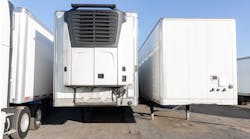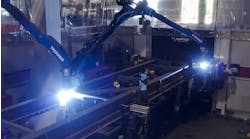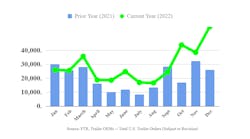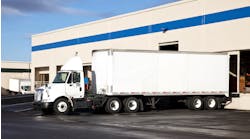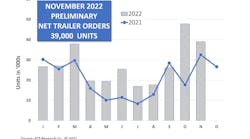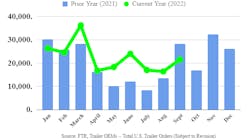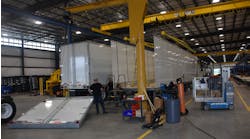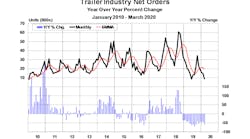The US trailer industry is shifting from the production and capacity challenges of the last three years, with their corresponding pressures on the component and material supply chains, to a “massive retrenchment” in production levels, according to ACT Research in its latest Trailer Components Report.
In addition, industry analyst FTR Intel reports preliminary net trailer orders for April sunk to the lowest levels recorded in the modern era, coming in at only 300 units, meaning order activity was down 95% month-over-month and 98% year-over-year.
Trailer orders for the past 12 months now total 162,000 units, FTR said.
“While there was no indication of any widespread COVID-19 lockdown-driven shutdowns at trailer OEMs in the past quarter, the dramatic cessation of fleet investment has caused OEMs to quickly reassess their production volumes and staffing needs,” said Frank Maly, director of commercial vehicle transportation analysis and research at ACT. “The short-to-medium term outlook will be entirely dependent upon the return of business to some level of normality and stability, which will drive freight demand for both manufacturing and consumer spending.
“Higher freight demand will eventually challenge fleet capacity, and drive an improvement in freight rates, which will help build fleet confidence and generate the desired combination of equipment need and ability to pay. However, the path to get to that point likely will be arduous.”
ACT’s trailer report alerts readers, in the meantime, to “expect trailer OEMs, where possible, to pull orders forward in an attempt to maintain production levels until the inevitable reductions in line rates and staffing occur,” which also will challenge materials and component suppliers, as bills-of-material will likely shift in both timing and specifications.
FTR’s April order activity reflects the challenges fleets and trailer manufacturers are facing.
Severe recessionary conditions caused many fleets to pull back on orders previously scheduled for 2020 delivery and place few new orders, FTR said. The dry van segment was hit particularly hard and refrigerated van orders suffered some as well. Vocational orders remained tepid after falling significantly in March. Some specialty segments are holding up better under the stress. Numerous OEM plants were shut down for part of April—some for health reasons, some for lack of orders and some for a combination of the two.
“Fleets remain in a severe wait-and-see posture until they can evaluate the damage done to the freight markets from the pandemic,” said Don Ake, FTR vice president of commercial vehicles. “Since the recovery from the economic crisis is highly dependent on the status of the health crisis, there is a huge amount of uncertainty in the trailer market. Buying activity appears to be on hold until the fleets can see a clear path forward. The bigger fleets will resume replacing old trailers as soon as they see the economic restrictions lifted and freight growing again.
“The key element to the trailer market recovery is for fleet confidence to improve. Carriers saw freight softening at the beginning of the year and then it cratered due to the recession caused by COVID-19. There are still way too many uncertainties present for fleets to buy new trailers in large numbers. They will take the minimum number of trailers needed in the short-run and then increase quantities dependent on the speed and size of the recovery. Orders should improve soon, but are expected to remain modest for the next few months.”

